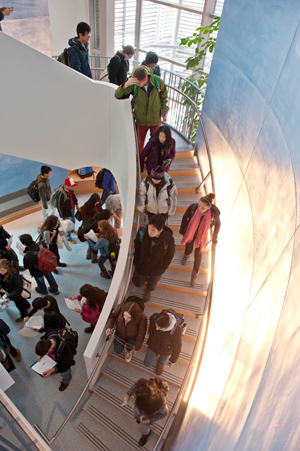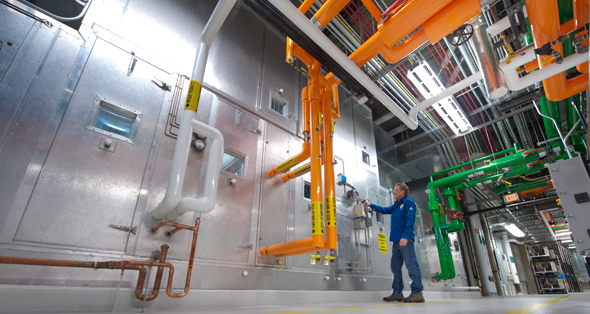
- About
- Departments
- Construction on Campus
- Service Requests
Back to Top Nav
Back to Top Nav
The science of life has a new home at Dartmouth. Under construction since September 2008, the Class of 1978 Life Sciences Center has been up and running for academic business since fall term classes began in September.

Natural light and curving staircases enhance the Life Sciences Center’s welcoming feel. (Photo by John Sherman)
Encountering the building, you are immediately aware that it is alive, and not just in the science it houses. Its vitality is rooted in ecological design and in the intellectual growth it fosters. Colleagues in the Department of Biological Sciences once dispersed across campus now gather under a common roof, where the social supports the scientific. Set near the northern edge of the campus adjacent to Dartmouth Medical School, the Life Sciences Center (LSC) is an unmistakable addition to the College’s skyline. Inside, the state-of-the-art structure houses a variety of research and teaching spaces, all designed to facilitate a collaborative approach. Its welcoming galleries, curving staircases, and laboratories and casual nooks illuminated with natural light all frame the future of science and the forward-thinking education at Dartmouth. Solving Big Problems, Together Science today is a rapidly changing, interdisciplinary enterprise in which the researcher is no longer isolated physically or intellectually from colleagues. Twenty-first century science—the life sciences in particular—relies heavily on a cooperative approach among its practitioners. “At its core, the Life Sciences Center was designed to allow people to come together in teams and solve problems of great impact,” says Provost Carol Folt, the Dartmouth Professor of Biological Sciences. “Scientists working in this building, and indeed the students we teach, are seeking solutions to urgent problems—from climate change to poverty, environmental degradation and human health to mental illness and genetic disorders.” “Any medical advance, any cure or treatment is typically based on 10, maybe even 20 years of basic research,” explains Patrick Dolph, associate professor of biological sciences, who seeks to understand the mechanisms of neuronal degenerative diseases such as Alzheimer’s. “And that’s why this particular building is so important. This is where the future of medical science or agricultural science lies.”
Laboratories utilize an open design in which the lack of physical walls becomes a lack of boundaries between disciplines as diverse as molecular, evolutionary, and environmental biology. “The building layout facilitates sharing of intellectual interactions between people because now everybody is not locked into their own kingdom,” says Mark McPeek, the David T. McLaughlin Distinguished Professor of Biological Sciences. “Now we’re all in a shared common space where everyone is always interacting.” Researchers and students are free to walk about and engage in discussions, confirms Celia Chen ’78, PhD ’94, research professor of biological sciences: “The open plan reminds me a bit of a one-room schoolhouse,” where everyone learns from each other. This environment supports not only Dartmouth’s current faculty, which Folt describes as “influential scientists who love to teach,” but also its ability to maintain and build for the future. “This building is going to be really key for our recruitment of new faculty,” says Mary Lou Guerinot, the Ronald and Deborah Harris Professor of the Sciences. “It’s one thing to say we’ll be building a new building in five years, and it’s another thing to have them walk in the front door, give their seminar in a fabulous auditorium, show them the space, and say, ‘This could be yours.’” Facilitating Innovative Teaching “The flexible nature of the building’s design encourages our faculty members to be creative and innovative in their teaching and research,” says Michael Mastanduno, Dean of the Faculty of Arts and Sciences. “Now they can reconfigure learning spaces—labs, classrooms, formal and informal meeting areas—as they pursue new ideas, explore them with their students, and collaborate among their colleagues.” Natalie Gentile, project manager at architectural firm Bohlin Cywinski Jackson, explains that the designers “were really trying to help the faculty develop some new pedagogical tools.” McPeek notes that, “The new classrooms are designed to move classes away from the standard lecture format and toward a learning experience in which students are full participants in class and not simply passive listeners.” Cristina Herren ’12, a student of McPeek, is participating in research and thriving in the new facility. “The labs are integrated into the first floor, making them more accessible, and are well organized and spacious,” Herren says. “It is a good setting for learning hands-on science.” In the teaching spaces that accommodate about 80 students, white boards and electronic flat screen panels cover the walls, and classroom furniture is easily rearranged. The reconfigurable classrooms facilitate more interaction and more small-group learning, says Guerinot. “I can go from having all the students facing the front of the room to having them break out into groups,” each with access to a dedicated display screen, she says. When small groups report back, the teacher can take what students have developed and project it for the entire room to see. Guerinot observes that readjusting one’s teaching style can be challenging, and exploring new approaches requires imagination and time to “adjust to the possibilities.” Beyond Lab and Classroom The building supports crucial informal work, too. Beyond labs, classrooms, and offices, notes Professor Thomas Jack, chair of the Department of Biological Sciences, one of the special things about the Life Sciences Center is its profusion of informal spaces throughout the building, creating spaces for quiet study or small group meetings. “Great ideas are rarely forged in the laboratory,” says Ryan Calsbeek, assistant professor of biological sciences. “It’s more often over a cup of coffee, chatting with a friend, hanging out in the casual spaces that are all over this building.” Caitlin Keenan ’12 calls the Life Sciences Center “welcoming and warm. I think it strikes a great balance between a comfortable atmosphere and state-of the art, modern looks.” Simone S. Whitecloud, a PhD candidate in ecology and evolutionary biology, likes the informal areas “because they encourage students to arrive for class early and linger afterwards. It motivates continuing discussions outside of class.” The building is designed for function and efficiency—it consumes 30 to 35 percent less energy than standard construction. (Photo by John Sherman) Form Follows Function In the Life Sciences Center, remarks Professor Thomas Jack, “we have an aesthetically beautiful building, … but they’ve also engineered a highly functional building. To get a building which is totally functional and as beautiful as this one is, is really an impressive feat.” The LSC utilizes innovative design and imaginative execution, yielding an annual energy cost savings of 30 to 35 percent when compared with buildings of standard construction. “Much of this was achieved through an extensive building exterior envelope system consisting of triple-glazed windows, spray-on foam insulation and an air/vapor barrier, along with numerous internal energy conserving systems,” notes Joe Broemel, Dartmouth’s project manager for the building. The results of this strategy were apparent even before the building was complete. “Last winter during construction, the contractor bought 26 temporary heating units to heat the interior,” says Broemel. “By mid-February we had unplugged all but about six of them because the building was so tight it retained the heat and the other units weren’t necessary.” An air sampling system monitors the air continually, allowing minute adjustments in airflow that result in energy cost savings. Rooftop rainwater is channeled into six 10,000-gallon storage tanks and used in the building’s graywater systems, conserving drinking water for its intended use. Several “green” roofs constructed of layered soil topped with cultivated grasses also help the energy budget. “The advantage of a green roof is that in the summer it provides some cooling to the building because it doesn’t heat up as much as a tile roof, and in the winter it provides a bit of heat retention,” Jack explains. Dartmouth People Shape a Dartmouth Building It’s fitting that a building so in sync with the way that science is done at Dartmouth was supported by people with strong ties to the College. A substantial gift from the Class of 1978 made the construction of the approximately 174,500-square-foot building possible. Bill Daniel ’78 voices a sentiment undoubtedly shared by his classmates: “The Class of 1978 Life Sciences Center is an incredible opportunity for our class to make a difference for the future students at Dartmouth.” Celia Chen, a member of the Class of 1978 as well as a member of the faculty, adds a personal thanks to her fellow classmates: “I think the entire College is grateful to [our class]. … I see first-hand the improvement in life sciences education that this building brings to our campus.” The new facilities also honor Dartmouth’s own. The Hannah Croasdale Commons recalls the inspiration that this pioneer, Dartmouth’s first female tenured professor, gave students over her more than 40 years as part of what is now the Department of Biological Sciences. Croasdale, who retired as a full professor in 1971, died in 1999 at the age of 93. The 200-seat Arvo J. Oopik ’78 Auditorium, funded by a gift from Kathy and Rick Kimball ’78, honors a late classmate and Indian Health Service cardiologist. The Petit Family Gallery honors the family of William Petit ’78. Into the Future The Class of 1978 Life Sciences Center provides the perfect spaces for “learning by doing,” says Folt. “It’s a campus model for how research and teaching happen at Dartmouth today, not only in the sciences, but in every discipline.” In that spirit, the Life Sciences Center is part of an ongoing renewal of older campus academic spaces to enable the work of the faculty. This includes areas like Dartmouth Row, spaces for the social sciences, and the arts district, where the Hopkins Center for the Arts and the Hood Museum of Art will be joined by the new Visual Arts Center when it opens in fall 2012. With the College’s Strategic Planning process underway, it’s fitting that, as with the Life Sciences Center, Dartmouth’s academic buildings should inherently and intentionally support the programs and people they house. View more images of The Class of 1978 Life Sciences Center. See the slideshow on Dartmouth’s flickr site.
lifescimech-590.jpg
